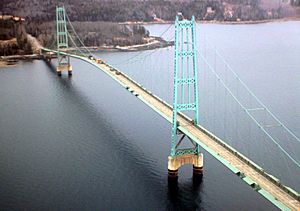Deer Isle Bridge facts for kids
Quick facts for kids Deer Isle Bridge |
|
|---|---|
 |
|
| Coordinates | 44°17′38″N 68°41′20″W / 44.2940°N 68.6888°W |
| Carries | Motor vehicles, pedestrians, bicycles |
| Crosses | Eggemoggin Reach |
| Locale | Deer Isle, Maine |
| Characteristics | |
| Design | Suspension |
| Longest span | 1,088 feet (332 m) |
| Clearance below | 85 feet (26 m) |
| History | |
| Construction end | December 31, 1938 |
| Opened | December 31, 1939 |
| Statistics | |
| Daily traffic | 123 |
The Deer Isle Bridge is a suspension bridge in Maine, a state in the United States. It stretches across a body of water called Eggemoggin Reach. This bridge is super important because it's the only way for cars, bikes, and people to get from the mainland to Little Deer Isle.
The bridge was finished in March 1939. Its main part, called the main span, is 1,088 feet (332 m) long. Two clever engineers, Holton Duncan Robinson and David Bernard Steinman, designed it.
When it was first built, the bridge had some issues with wind making it sway. This was similar to problems seen with the Whitestone Bridge and the first Tacoma Narrows Bridge. The Tacoma Narrows Bridge even collapsed because of wind!
To fix the swaying, extra cables called "cable stays" were added. These cables connect the main cables to the bridge deck and towers, making the bridge much stronger. Today, the bridge carries two narrow lanes of State Route 15.
In 2008, the bridge got a new deck. Then, in 2010, it was repainted to keep it looking good and protected.
Contents
Building the Deer Isle Bridge
The Deer Isle-Sedgwick Bridge, as it's officially known, connects Deer Isle to the mainland. Before this bridge, people had to use a ferry, which wasn't very good. The bridge made it much easier for people to visit Deer Isle, helping tourism grow.
Why Was the Bridge So Special?
This bridge was amazing because its designers and builders found smart ways to create a strong, long, and high bridge. They built it across a busy part of the Atlantic Ocean without spending too much money. They used parts that were made in factories and even some materials that had been used before. This helped keep costs down.
Challenges for the Builders
Building the bridge was tricky for the engineers, David B. Steinman and his team.
- Boats needed space: Eggemoggin Reach is popular for yachts. So, the bridge needed a wide channel (200-foot-wide (61 m)) and had to be very high (at least 85-foot (26 m) above the water). This meant the road was 98.7 feet (30.1 m) above the water!
- Short approaches: The ground where the bridge foundations were built was very deep. This meant the ramps leading up to the bridge had to be short. To solve this, they made the ramps quite steep (6.5 percent grade) and added a short curve at the center of the main span. This way, they got the height they needed without long ramps.
Working in Winter Weather
The project also had to be finished by early summer. This meant a lot of the building happened during the cold winter and early spring. To deal with the bad weather, the builders made many parts of the bridge in factories away from the site. Then, they quickly put these parts together on site, often working between high tides. This smart planning helped them finish on time and on budget, even with tough weather.
Smart Building Methods
The way the bridge's base (substructure) was built was very new for its time. Instead of building the steel forms for the main tower bases on site, a company called Merritt-Chapman & Scott made them in their yard in New York. They then brought these huge pieces to Maine by barge. They even used recycled steel, which saved a lot of money. These pre-made parts were put together on barges near the building site. After cleaning the seabed, the bases were cut to fit the rocky bottom and then filled with concrete.
New Cable Technology
For the main cables and the smaller suspender cables, the designers used a new type of pre-stressed twisted-strand cable. These special cables meant that workers didn't need to spend a lot of time making small adjustments on site, which saved time and money. These cables were first used in the U.S. in 1931 on the Waldo–Hancock Bridge and the St. Johns Bridge.
Another new idea was how the main cables were connected. They used "sleeve nuts" to easily adjust the main cables. This method, invented by Robinson, made fine-tuning the bridge much simpler.
Fixing Wind Problems
Before the bridge was fully finished, engineers noticed it swayed too much in the wind. This was because the bridge deck was quite light. To make it more stable, diagonal cables were added from the main cables to the stiffening girders on both towers.
However, during very strong storms in the winter of 1942–1943, the bridge still moved a lot, and some of these new cables broke. With the recent collapse of the Tacoma Narrows Bridge fresh in everyone's minds, stronger and more extensive diagonal cables were added. These new cables ran both lengthwise and across the bridge, making it much safer and more stable.

